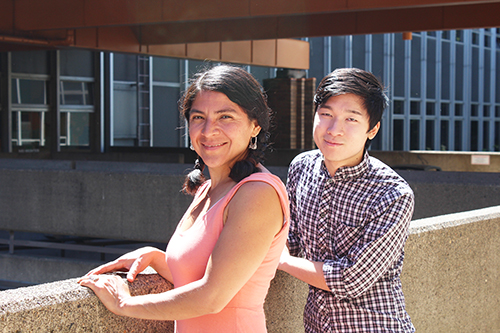As school let out for the summer, two Portland State students were getting some great news and some great prizes. Patricia Vazquez Gomez, an Art and Social Practice graduate student, and Jordan Hoagbin, a sophomore studying graphic design, were announced as the first- and second- place recipients, respectively, of the first-ever Arlene Schnitzer Visual Arts Prize.
1st round of PSU students awarded Schnitzer Visual Arts Prize

this year’s Schnitzer Visual Arts award winners, stand in front of the Autzen Gallery, where their work will be featured this September. Photo by Corinna Scott
As school let out for the summer, two Portland State students were getting some great news and some great prizes. Patricia Vazquez Gomez, an Art and Social Practice graduate student, and Jordan Hoagbin, a sophomore studying graphic design, were announced as the first- and second- place recipients, respectively, of the first-ever Arlene Schnitzer Visual Arts Prize.
The prize, created earlier in the year by a gift from the Harold and Arlene Schnitzer CARE Foundation, aims to get the word out about the art that PSU students create. Once the prize was unveiled, students were able to create a portfolio to submit for consideration by a panel of jurors.
Vazquez Gomez, whose submission included paintings, murals and videos, received a $5,500 cash prize for first place. Vazquez Gomez focuses on social issues in her artwork. The portfolio, she said, is a representation of how her work has grown and changed over the years as she realized she wanted to work more closely with people. One of the pieces Vazquez Gomez submitted was a video project about a mother who immigrated to the U.S.—and her children, who had to stay behind in Mexico.
Vazquez Gomez explained that she became friends with the woman while volunteering in the community; as she heard more of the story, she found inspiration. Vazquez Gomez traveled frequently between Mexico and the U.S.; while in Mexico, she would record images of and messages from the woman’s three daughters, and then repeat the process with the mother in the U.S.
Vazquez Gomez said that when she submitted her portfolio in May things were so busy in her life and with school that she nearly forgot about the prize until she got a phone call informing her that she had won. She was impressed by the work her peers submitted and was surprised she was chosen.
Vazquez Gomez feels supported by all her peers and classmates in the master’s program, and is proud of what art can do for social work. “We are sort of developing a new practice, and a lot of times we have questions of how valid it is as art, so the validation of the practice of this hybrid is really great,” Vazquez Gomez said. “Not only for me but for all my peers across this concentration.”
Hoagbin, the graphic design student who received the $4,000 second-place prize, said that since he’s only a sophomore he didn’t have many pieces to choose from for his submission. He wanted to submit work that showed a breadth of capability and versatility. “I feel like that was kind of what got me the win. With art you can have your own style, but with design you can’t really be personal about it; you have to address each project differently.”
It seems that Hoagbin is right; the press release announcing the winners quoted the jurors as saying, “it is clear that he has no one style or go-to visual solution, but instead, he approaches each brief as a unique challenge.”
“I think it’s an interesting and different approach to design, where it’s not specialized in one special thing,” Hoagbin said. “You’re brought a question, and you get to come up with a fun, creative way to go about [answering] it.”
Hoagbin said that at this point his major requires him to focus on either print or interactive design, and he hasn’t decided which he wants to pursue. He has mainly been focusing on his work and meeting other people in the industry.
Indeed, one of the jurors was Don Rood of Felt Hat Design. Hoagbin said Rood contacted him and posed an opportunity for an eventual job.
An exhibition featuring Vazquez Gomez’s and Hoagbin’s work will be held in PSU’s Autzen Gallery this fall, from Oct. 3 to Nov. 1. An official reception and awards ceremony will be held Oct. 24 during Portland State of Mind week.
Hoagbin said that he thinks the exhibition will be interesting because his works are so different from Vazquez Gomez’s, who comes from a different area of the field. “Patricia, she’s an artist in the social practice program…they [bring the] focus away from making objects and want to talk more about…art and art practices,” Hoagbin said.
Vazquez Gomez agrees that her work has become less “at home” in gallery settings since she took up her social work concentration. “It’s not necessarily object-based. It’s about setting up pieces for participation and for dialogue,” Vazquez Gomez said.
Hoagbin is looking forward to sharing exhibit space with Vazquez Gomez. “I feel like making objects with someone who doesn’t make gallery work is an interesting way to think about approaching an exhibit,” Hoagbin said. “I think it should be something fresh, something different.”





